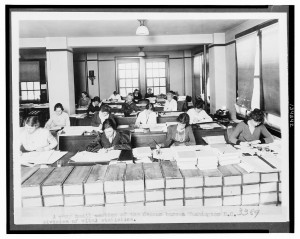Nothing like jumping in and seeing if you sink or swim. There is no goofing off and easing into the subject matter with this course. You are into the meat of the subject from page one, which is great! Don’t get me wrong, I am happy to start off strong. There is just a lot, and I mean a lot, of information.
Library of Congress Prints and Photographs Division Washington, D.C. 20540 USA. cph 3c34542 http://hdl.loc.gov/loc.pnp/cph.3c34542
These first two modules cover the U.S. Census from 1790-1940. There are detailed explanations of what is on the census, why it was there, how it changed, and what the data means. That is a lot of information covered 15 times over. Good, needed, and useful, but a lot of information.
I particularly appreciate the breakdown for each census on what was asked. Seeing it typed out in list form made it easier to digest and understand than just looking at it across the top of a census page. It was also fascinating to see how that information changed, evolved, and grew over the decades. I could easily see how the census became an incredible source for statistical information about the population of the United States at that time.
The section on strategies for using the Federal Census was particularly good. Three examples were given on ways that researchers can analyze the information on the records, particularly when they are tracing a person or a family through multiple census years. Of course, you might have a way that you like to do it that is not at all like they suggest, but it was great to see how other people might analyze the information.
When I am tracing a family through the census I tend to use a timeline approach. Each person is placed on a timeline and the information for each year is placed on the chart. When this is used in conjunction with a narrative (all of the information from the record written out in words) a nice flowing chart comes together. Other people use worksheets, but that makes my head hurt from information over load.
What I think is the important takeaway message is that we each have different ways we like to breakdown and analyze the information we come into contact with. As long as we are consistent, don’t miss items, and can understand what is presented our method doesn’t matter. If you don’t have a consistent method though, you might want to read this section extra carefully and try the three proposed analysis suggestions.
By Shannon Bennett, Student
Views: 48
Comment
© 2024 Created by IIGSExecDirector.
Powered by
![]()

You need to be a member of Genealogy Wise to add comments!
Join Genealogy Wise